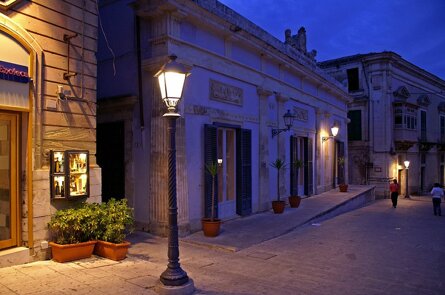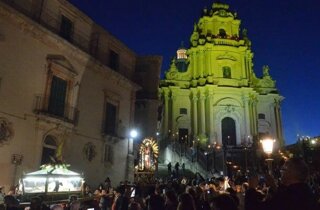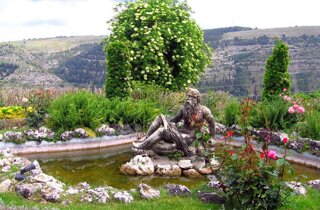
Follow us on:
Cell. 351 9008561
Street F. lli Belleo n. 161 (RG)
e-mail: saroshomes@gmail.com
Ragusa Ibla

Ragusa Ibla, or simply Ibla, is one of two districts that form the historic centre of Ragusa, Sicily. In the dialect of ragusa, the district is also called the Iusu (i.e. the lower Ragusa, to distinguish it from the top).
After the earthquake of 1693, the city of Ragusa, the ancient was rebuilt by implementing shipyards that produced works, buildings and monuments of the taste of the late baroque. In it there are 14 of the 18 monuments in the city of Ragusa, today inscribed in the world heritage site.
The ancient city contains over fifty churches and numerous palaces in the baroque style. In the eastern part, is the Ibleo Garden, and there are also excavations of an ancient city that according to several historians would be identifiable with the Hybla Heraia.
Below in the photo the illuminated dome of the church of San Giorgio and cathedral of San Giorgio.


In 1865, the neighborhood is detached administratively from the rest of the city, becoming independent municipality under the name of Ragusa inferiore (Lower Ragusa, a name which it maintained until 1922 when it was changed to Ragusa Ibla.
It remained an independent municipality until 1927, when they gathered at the municipality of Ragusa, composed by the neighborhoods built on the hill of Patro.
Below in the picture, the landscape lit up and the circle of Ibla.


One of the peculiarities of the country consists in being able to see walking down ancient stairways, connecting upper Ragusa to Ragusa Ibla.
Ragusa Ibla is lived and imagined by some as a living nativity scene, mainly thanks to the night lights that illuminate it as if it were invested with the magic of christmas.
All of this is enhanced by the presence of narrow passages, which lead to the ancient houses, on foot while admiring the view of a typical time.
To the side in the picture, the landscape illuminated as seen from the church of Santa Maria delle Scale.


The Ibleo garden is the oldest of the four gardens of Ragusa.
The villa Ragusa Ibla was built in 1858 on the initiative of some local noble and a good part of the people who worked for free for the realization of the work.
Stands on a spur of rock that overlooks the valley of the Irminio, at the eastern end of the town about; the entrance is by a magnificent avenue flanked by palm trees, is adorned with benches, well-carved columns with stone jars carved in different forms and a elegant balcony with a fence in the limestone. Impressive at the centre of the villa, the monument to the fallen of the great war. Inside you will find the church of St. Vincent Ferrer, the church of San Giacomo and the church of the Capuchins.
To the side in the picture avenue of the villa Ibla. Under the landscape.

Ibla, today, is full of local restaurants, pubs and events that are held during various times of the year. The latter, they do no more than revive and enhance even more the beautiful places that our country possesses.
Some of these places are chosen for the fiction "Il Commissario Montalbano" and in other movies.
The villa Ibla, the so-called "Giardini Iblei", in part, recently renovated, includes a small church, a restaurant and a large playground for children.
The church's most impressive Ibla, as the Duomo, is San Giorgio. Not for nothing is the choice by couples who want to join in marriage. The Cathedral of San Giorgio makes his only on that day thanks to his particular scenario, and magic.


























